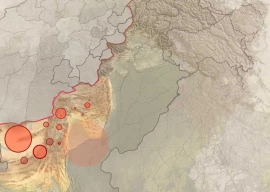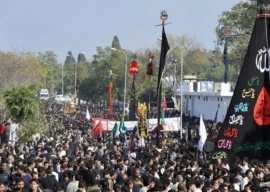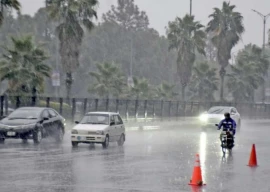
In 2010-11, K-Electric – formerly known as Karachi Electric Supply Company – posted a net loss of Rs9.3 billion. In the three previous fiscal years, its average annual loss was Rs15.33 billion.
Things changed this time around though. This June, it closed the fiscal year with a profit of Rs12.8 billion and a surprise dividend for shareholders.
The power utility has come a long way since it was privatised in 2005. From a company beset by rampant theft, network of rickety power lines and corruption, it has emerged as a benchmark for other electricity suppliers in Pakistan.

Interestingly, the company has not gained from the liberal rate of return guaranteed by the state to other investors in the power sector. Instead, it is the multi-year tariff based on how efficiently it runs the system that determines its profits.
“Whoever came up with the multi-year tariff model knew that investment would be needed to fix the problems,” says Syed Moonis Abdullah Alvi, the company’s chief financial officer.
Under this arrangement, K-E was required to invest in revamping the power grid, curb theft and improve utilisation of its power plants. The more it achieved on these counts, the more money it made.

A major contributor to the bottom line is what the company calls fleet efficiency, enhancement in the output of its power plants, in essence, by reusing the waste heat. This means higher electricity generation while consuming same quantity of fuel.
“Our fleet efficiency was 30% in 2009. Now it has touched 37%,” Alvi said in an interview, explaining that one percent annualised gain in efficiency adds Rs2 billion to profit.
The company expects to improve the efficiency of its power plants to 40-41%. It is already converting four gas generators at its 220-MW power plant to the combined-cycle model.
More significantly, K-E has contracted Descon to build a special system at two of its power production sites that will channel waste heat to a boiler before the resultant steam is reused to generate additional electricity.
Alvi said that this is first time such a thing was being tried with the General Electric’s Jenbacher engines. K-E has a total of 64 engines installed at Korangi and SITE power plants that together have a capacity to produce 180MW, which after conversion will go up to 200MW.

Another area that has helped add to the profit is the reduction of transmission and distribution losses, which have come down to 25% from 36% in 2009, the year Dubai-based private equity Abraaj Capital bought a stake in the company along with management control.
The company estimates that 1% less transmission and distribution loss translates into Rs2.5 billion in savings.
Of the Rs12.89 billion it made in profit last fiscal year, around Rs3.3 billion was a result of deferred taxation, the CFO said.
Consumers beg to differ
Despite the CFO’s statements over improvement in power delivery and bill collections, some hisses continue to surface in the shape of stories related to inflated billing, undue charges and high-handedness on part of K-E’s staff.
One such matter relates to the collection of security deposits. K-E consumers including households and factories have received bills that carry “arrears”, which people decline exist.
If, in fact, they are not part of a missed monthly payment, then the “arrears” are a security deposit, a kind of an insurance against the sanctioned power load.
K-E says it is not doing anything illegal. The rationale behind the move, it says, is that households are using more electricity than what they were sanctioned when they first occupied the residence.
For instance, some households, which were allowed connection of 2 kilowatt in 1990, now consume 15kw.
Since a physical survey to count the number of electrical appliances was not possible, maximum consumption was worked out to determine the amount of security deposit.
“Let me be clear —this does not add to our income. The security deposit is a liability for the company. The day you severe the connection, we will hand back the amount,” says Alvi.
The question that boggles is that security deposits have already been submitted — at least that is a reasonable assumption.
This is where K-E finds itself in a tight spot. Over the years, K-E has seen many changes in management, causing customers’ records to go missing.
“The onus of providing the record lies on the customer,” said Alvi. “If anyone has reservation, then they can approach National Electric Power Regulatory Authority (Nepra). K-E has complied with the Customer Service Manual.”
Up till now the company has collected around Rs400 million through bills under this head. “K-E has an overall security deposit of Rs6 billion, which is not even half of the Rs15 billion it collects in monthly bills,” he said. “In any other utility, the security deposit would cover bills for 1.5 months.”
However, considering the efforts K-E has put in to winning the confidence of its customers, it would have been better if people were informed first.
A simple note attached to bills would have done. However, the situation now leads customers to believe that they are being charged excessively when, K-E claims, that it is the security deposit being charged.
Company’s Chief of Staff Usama Qureshi explained: “We couldn’t mention a separate account (for security deposits) on the bills because there is not a field available to charge it on the bill. However, we do mention details in a ‘message box’ on top of the bill.”
The officials insist the company does not unfairly charge consumers. “People think we squeeze money out of every corner,” said Alvi. “If we were doing that then we would have probably made much more.”
Gas woes
The company says it has tried to keep electricity affordable. Of the total 2,300MW of its installed generation capacity, around 1,000MW has been added in the past five years.
This additional generation is based on cheaper gas instead of imported furnace oil.
But K-E says it is being denied the committed gas quantity of 270 million cubic feet per day (mmcfd). “Last year, we received average of 164mmcfd,” says Usama, who is also K-E’s point man on fuel-related matters.
The importance of gas can be gauged from the fact that K-E’s current average tariff of Rs17 per kilowatt hour (kwh) would go beyond Rs20 kwh if power plants are run solely on furnace oil.
Challenge lies ahead for K-E and other power companies as Pakistan prepares to import LNG to bridge the widening gap between demand and supply of gas from domestic reserves.
According to some estimates, imported LNG will cost between $13 and $15 per unit against the current average price of $4 per unit.
Alvi said the government will continue to bear the burden of electricity subsidy if imported LNG is entirely allocated for the power plants.
“That is why we think average pricing is the way forward. It doesn’t make sense to further increase power bills, which range between Rs3,500 and Rs5,500. But the average gas bill of Rs300 could surely be raised a bit,” he said.
Upcoming changes
Unlike other utilities, K-E does not have any fixed rate of return on its investment. Capital expenditure, like money spent on replacing old power lines, does not get passed on to consumers as part of tariff, says Alvi.
“We get depreciation, which covers the cost over a period of say 20 years. We only have the operations and management head in the tariff that often falls short of meeting our costs,” he said.
Now K-E has asked Nepra to unbundle the utility into three separate entities – a generation, transmission and distribution firm and decide the appropriate rate of return for each. “But we don’t expect this arrangement to affect the tariff,” says Alvi.
Published in The Express Tribune, September 26th, 2014.
Like Business on Facebook, follow @TribuneBiz on Twitter to stay informed and join in the conversation.
















COMMENTS
Comments are moderated and generally will be posted if they are on-topic and not abusive.
For more information, please see our Comments FAQ